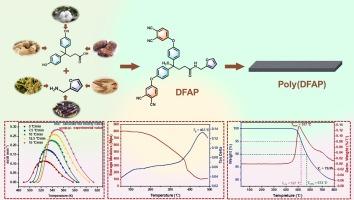一种新型生物基自催化酰胺型邻苯二腈单体:合成、固化动力学和热性能
IF 5.8
2区 化学
Q1 POLYMER SCIENCE
引用次数: 0
摘要
以生物质中的双酚酸和糠胺为原料,制备了一种生物基双酚化合物(DFA)。然后,在一种环境友好型溶剂中获得了一种生物基酰胺邻苯二腈单体(DFAP)。核磁共振和傅立叶变换红外光谱(FT-IR)证明了 DFA 和 DFAP 的成功合成。利用傅立叶变换红外光谱和差示扫描量热法研究了聚合物的固化行为和固化动力学。使用等转化法计算活化能。通过引入可变活化能模型,对描述聚(DFAP)固化过程的 SB(m,n)自催化反应模型进行了修改和拟合。利用热重分析仪、动态机械分析仪和流变仪等技术对树脂的热稳定性、热机械性能和加工性能进行了研究。结果表明,该预聚物具有较宽的加工窗口和较低的熔体粘度。聚(DFAP)具有较高的玻璃化转变温度和出色的热稳定性。本文章由计算机程序翻译,如有差异,请以英文原文为准。

A novel bio-based autocatalytic amide-type phthalonitrile monomer: Synthesis, curing kinetics and thermal properties
A bio-based bisphenol compound (DFA) was prepared using bisphenolic acid and furfurylamine in biomass as raw materials. Then, a bio-based amide phthalonitrile monomer (DFAP) was obtained in an environmentally friendly solvent. Nuclear magnetic resonance and Fourier transform infrared spectroscopy (FT-IR) proved the successful synthesis of DFA and DFAP. The curing behavior and curing kinetics of the polymer were studied using FT-IR and differential scanning calorimetry. Calculate the activation energy using the isoconversion method. The SB(m, n) autocatalytic reaction model describing the curing process of poly(DFAP) was modified and fitted by introducing the variable activation energy model. The thermal stability, thermomechanical properties and processing properties of the resin were studied using technologies such as thermogravimetric analyzer, dynamic mechanical analyzer and rheometer. The results show that the prepolymer has a wide processing window and a low melt viscosity. Poly(DFAP) has a high glass transition temperature and excellent thermal stability.
求助全文
通过发布文献求助,成功后即可免费获取论文全文。
去求助
来源期刊

European Polymer Journal
化学-高分子科学
CiteScore
9.90
自引率
10.00%
发文量
691
审稿时长
23 days
期刊介绍:
European Polymer Journal is dedicated to publishing work on fundamental and applied polymer chemistry and macromolecular materials. The journal covers all aspects of polymer synthesis, including polymerization mechanisms and chemical functional transformations, with a focus on novel polymers and the relationships between molecular structure and polymer properties. In addition, we welcome submissions on bio-based or renewable polymers, stimuli-responsive systems and polymer bio-hybrids. European Polymer Journal also publishes research on the biomedical application of polymers, including drug delivery and regenerative medicine. The main scope is covered but not limited to the following core research areas:
Polymer synthesis and functionalization
• Novel synthetic routes for polymerization, functional modification, controlled/living polymerization and precision polymers.
Stimuli-responsive polymers
• Including shape memory and self-healing polymers.
Supramolecular polymers and self-assembly
• Molecular recognition and higher order polymer structures.
Renewable and sustainable polymers
• Bio-based, biodegradable and anti-microbial polymers and polymeric bio-nanocomposites.
Polymers at interfaces and surfaces
• Chemistry and engineering of surfaces with biological relevance, including patterning, antifouling polymers and polymers for membrane applications.
Biomedical applications and nanomedicine
• Polymers for regenerative medicine, drug delivery molecular release and gene therapy
The scope of European Polymer Journal no longer includes Polymer Physics.
 求助内容:
求助内容: 应助结果提醒方式:
应助结果提醒方式:


